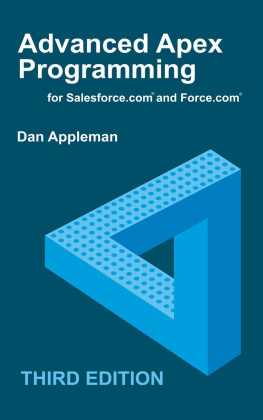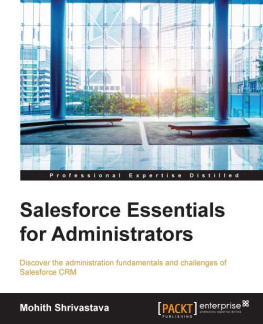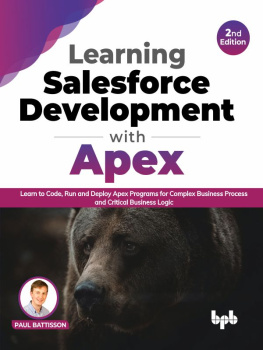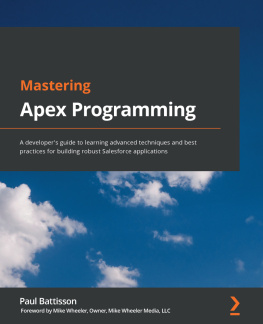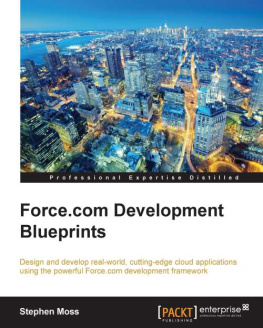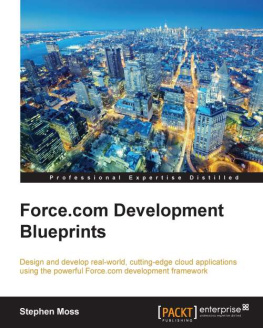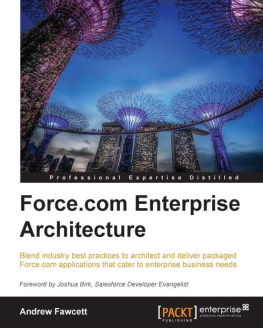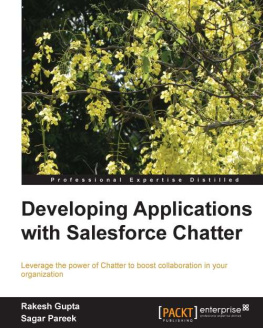Dan Appleman - Advanced Apex Programming for Salesforce.com and Force.com
Here you can read online Dan Appleman - Advanced Apex Programming for Salesforce.com and Force.com full text of the book (entire story) in english for free. Download pdf and epub, get meaning, cover and reviews about this ebook. year: 2015, publisher: Desaware Publishing, genre: Computer. Description of the work, (preface) as well as reviews are available. Best literature library LitArk.com created for fans of good reading and offers a wide selection of genres:
Romance novel
Science fiction
Adventure
Detective
Science
History
Home and family
Prose
Art
Politics
Computer
Non-fiction
Religion
Business
Children
Humor
Choose a favorite category and find really read worthwhile books. Enjoy immersion in the world of imagination, feel the emotions of the characters or learn something new for yourself, make an fascinating discovery.
- Book:Advanced Apex Programming for Salesforce.com and Force.com
- Author:
- Publisher:Desaware Publishing
- Genre:
- Year:2015
- Rating:3 / 5
- Favourites:Add to favourites
- Your mark:
- 60
- 1
- 2
- 3
- 4
- 5
Advanced Apex Programming for Salesforce.com and Force.com: summary, description and annotation
We offer to read an annotation, description, summary or preface (depends on what the author of the book "Advanced Apex Programming for Salesforce.com and Force.com" wrote himself). If you haven't found the necessary information about the book — write in the comments, we will try to find it.
Dan Appleman: author's other books
Who wrote Advanced Apex Programming for Salesforce.com and Force.com? Find out the surname, the name of the author of the book and a list of all author's works by series.
Advanced Apex Programming for Salesforce.com and Force.com — read online for free the complete book (whole text) full work
Below is the text of the book, divided by pages. System saving the place of the last page read, allows you to conveniently read the book "Advanced Apex Programming for Salesforce.com and Force.com" online for free, without having to search again every time where you left off. Put a bookmark, and you can go to the page where you finished reading at any time.
Font size:
Interval:
Bookmark:
Advanced Apex Programming for Salesforce.com and Force.com
Third Edition
By
Dan Appleman
Desaware Publishing
San Jose, California
The author and publisher have taken care in the preparation of this book, but make no expressed or implied warranty of any kind and assume no responsibility for errors or omissions. No liability is assumed for incidental or consequential damages in connection with or arising out of the use of the information or programs contained herein.
Salesforce.com, Force.com, VisualForce and AppExchange are registered trademarks of Salesforce.com, Inc. Apex is a trademark of Salesforce.com All other trademarks are the property of their respective owners.
Editor: Marian Kicklighter
Copyright 2012-2015 by Daniel Appleman, All rights reserved.
Third eBook Edition
ISBN:
www.AdvancedApex.com
I just wanted to get that out of the way. I know there is sometimes value in the kind of book where 90% of the content is a rephrasing of the documentation and only 10% is new and interesting a good author can organize information to make it easier for beginners to learn. But they are frustrating for intermediate and advanced developers who have to sift endlessly through familiar content to find one or two nuggets of new material.
So Im going to assume that you either have read, or can read, the Force.com Apex language documentation. If you are new to Apex, you will find this book helpful especially if you are coming to Apex from another language, but it is not a tutorial and will not replace the Apex documentation. If you have Apex programming experience, Im confident youll find material here that will at the very least prove thought provoking, if not occasionally mind-blowing.
This book is about design patterns, best practices, and creative solutions to the kinds of problems developers face out in the real world.
You see, language documentation is generally written by the language team (or their technical writers) which is good, because they know the language best. But the language team members are rarely application developers thats not their job.
White-papers and application notes are generally written by technical evangelists and consultants who often do have real-world experience, but are limited by the focus and format of the particular white paper or article. Short articles (of which Ive written many) serve a purpose, but are often limited in the level of depth they can achieve.
If you want to bring together real-world experience in a format that allows for as much depth as necessary, and organizes the information in such a way that concepts build on each other to really teach the material you need a book. You need a book written by someone who actually writes production code, both as a consultant for individual clients, and as a developer of applications for distribution.
Which brings me to the story how I came to write this book.
For most of my career, I was a developer on Microsoft platforms proficient in C and C++, Visual Basic, VB .NET and C#. I ran (and still run) the company Desaware, that publishes a software licensing system for .NET (desaware.com) and now publishes my books (desawarepublishing.com). I also wrote a number of programming books, and spent quite a few years on the speaker circuit - presenting at conferences that focused on Microsoft technologies.
About eight years ago, a Salesforce consultant I know needed an Apex trigger written, and since I was one of the few programmers she knew, she asked me to take a look. Writing that first trigger was certainly easy enough though I suspect Id be embarrassed by the code if I looked at it now. I found myself spending more and more time working in Apex I found it to be both challenging and fun.
About five years ago, I joined her and two others to establish a new company, Full Circle Insights, to develop a new Salesforce application related to marketing and sales data and analytics. Visit fullcircleinsights.com if youre curious about the details. As CTO, I designed and built the application which evolved into a very large and sophisticated native AppExchange app (an app that runs entirely on the Force.com platform). In doing so, I learned a lot.
As I have always enjoyed sharing what I learn, I ended up writing this book. It contains all of the things that I wish I had known eight years ago when I first started working in Apex. Things that I learned the hard way. Things that are either not found in the documentation, or are hidden in a footnote somewhere when they should be plastered across an entire page in bold flashing neon.
Think of this as a companion to the Apex Language reference a commentary if you will. The focus is on the core language and design patterns. These are the essential foundations that you need to work effectively in Apex with the various platform features such as Lightning, VisualForce, Chatter, and so forth (topics that are important, and deserving of their own books, but are not covered here).
Parts of this book focus on concepts ways of thinking that will be fairly easy to follow, even for relative beginners and those completely new to Apex. But parts of this book focus more on advanced design patterns, and to really understand them, youll need to dig into the code, and preferably install and experiment with the samples. You may need to refer back to the language documentation. You may even find parts of the book to be too hard to follow on a first reading. In truth, the book would hardly deserve the word Advanced in the title if this were not the case. If you do find yourself getting stuck, skip or scan a section and then move on. Youll find it easier to digest the second time through.
By the time youre done, I think you will find it was well worth the effort.
Dan Appleman
dan@desawarepublishing.com
The Salesforce platform is updated three times a year. Some of the updates are minor, some more significant, and some lead to radical changes in what most would consider to be best practices. Best practices are tricky you cant assume that just because something is new, it represents the best way to do something.
Not only has the platform changed, but my own experience has changed or put another way, I keep learning as well. And since this is a book born of real-world experience, those new experiences are reflected in each new edition, along with those new platform features that seem truly useful.
In preparing this edition, I went through every word of text and every line of code. Some of the changes are structural Ive tried to be more consistent in naming conventions (while remaining true to my own belief that names should be descriptive). Keep in mind that Apex is a case-insensitive language, so any casing errors that may remain will not impact the functionality of the examples. There is, at long last, an index. And while there are numerous changes scattered throughout the text and code, here are the areas where the changes for this edition were most significant:
Chapters 3 and 4 The change from counting script lines to measuring CPU time was very new when the second edition came out. Chapters 3 and 4 have been edited and extended to include more information on benchmarking and a greater focus on CPU time. Youll even see an example where decreasing the number of lines of code executing (which was the optimization goal in the past) can increase CPU time.
Chapter 7 The chapter on asynchronous design patterns, which was rewritten for the second edition, has been rewritten again. The appearance of queueable Apex has radically changed the asynchronous landscape to the point where the design patterns that appear in the second edition have been rendered obsolete.
Font size:
Interval:
Bookmark:
Similar books «Advanced Apex Programming for Salesforce.com and Force.com»
Look at similar books to Advanced Apex Programming for Salesforce.com and Force.com. We have selected literature similar in name and meaning in the hope of providing readers with more options to find new, interesting, not yet read works.
Discussion, reviews of the book Advanced Apex Programming for Salesforce.com and Force.com and just readers' own opinions. Leave your comments, write what you think about the work, its meaning or the main characters. Specify what exactly you liked and what you didn't like, and why you think so.

